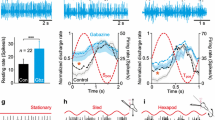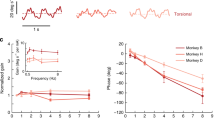Abstract.
The otolith system contributes to the vestibulo-ocular reflexes (VOR) when the head moves linearly in the horizontal plane or tilts relative to gravity. The saccules are thought to detect predominantly accelerations along the gravity vector. Otolith-induced vertical eye movements following vertical linear accelerations are attributed to the saccules. However, information on the neural circuits of the sacculo-ocular system is limited, and the effects of saccular inputs on extraocular motoneurons remain unclear. In the present study, synaptic responses to saccular-nerve stimulation were recorded intracellularly from identified motoneurons of all twelve extraocular muscles. Experiments were successfully performed in eleven cats. Individual motoneurons of the twelve extraocular muscles – the bilateral superior recti (SR), inferior recti (IR), superior obliques (SO), inferior obliques (IO), lateral recti (LR), and medial recti (MR) – were identified antidromically following bipolar stimulation of their respective nerves. The saccular nerve was selectively stimulated by a pair of tungsten electrodes after removing the utricular nerve and the ampullary nerves of the semicircular canals. Stimulus intensities were determined from the stimulus-response curves of vestibular N1 field potentials in order to avoid current spread. Intracellular recordings were performed from 129 extraocular motoneurons. The majority of the neurons showed no response to saccular-nerve stimulation. In 17 (30%) of 56 extraocular motoneurons related to vertical eye movements (bilateral SR and IR), depolarizing and/or hyperpolarizing postsynaptic potentials (PSPs) were observed in response to saccular-nerve stimulation. The latencies of PSPs ranged from 2.3 to 8.9 ms, indicating that the extraocular motoneurons received neither monosynaptic nor disynaptic inputs from saccular afferents. The majority of the latencies of the depolarization, including depolarization-hyperpolarization, were in the range of 2.3–3.3 ms. Latencies of hyperpolarizations were typically longer than those of depolarizations. Only one contralateral SO motoneuron of 43 recorded oblique extraocular motoneurons (bilateral SO and IO) showed a depolarization-hyperpolarization in response to saccular-nerve stimulation at a latency of 2.5 ms. None of 30 recorded horizontal extraocular motoneurons (bilateral LR and MR) responded to stimulation of the saccular nerve. The neural linkage in the sacculo-ocular system is relatively weak in comparison to the utriculo-ocular and sacculo-collic systems, suggesting that the role of the sacculo-ocular system in stabilizing eye position may be reduced when compared with utriculo-ocular and semicircular canal-ocular reflexes.
Similar content being viewed by others
Author information
Authors and Affiliations
Additional information
Electronic Publication
Rights and permissions
About this article
Cite this article
Isu, N., Graf, W., Sato, H. et al. Sacculo-ocular reflex connectivity in cats. Exp Brain Res 131, 262–268 (2000). https://doi.org/10.1007/s002219900292
Received:
Accepted:
Issue Date:
DOI: https://doi.org/10.1007/s002219900292




